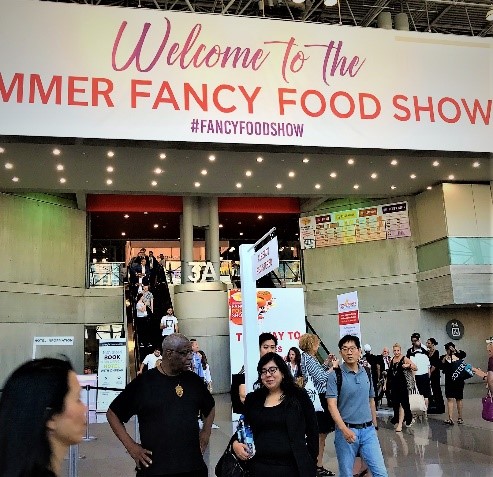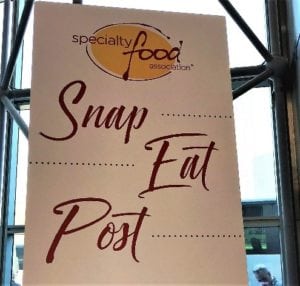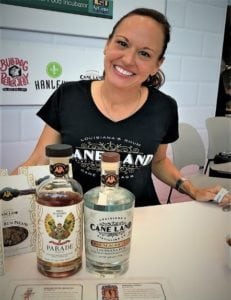
Eating, drinking and trending: Snack Attack
Snack Attack
If research from the Specialty Food Association and Mintel is correct, the market for snacks is growing (along with our waistlines?). Sales reached $127 billion reflecting a 15 percent increase between 2014-2016. While this might not seem significant, when compared with all food sales, where retail sales increased only 2.3 percent – the increased growth of specialty food items is remarkable.

The snacking segment holds 28 percent of the total specialty food market and sales reached $16.3 billion (2016), representing a 16 percent jump. Of the 13 snack segments, approximately half experienced growth of more than 20 percent with jerky and meat snacks in the lead.

Market Share. What You are Eating
• Refrigerated lunch and dinner entrees: 33 percent of market
• Yogurt and Kefir: 27.2 percent of the market
• Frozen lunch and dinner entrees: 18.1 percent of market
• Bread and baked goods:15.8 percent of market
• Chips, pretzels, snacks: 13.3 percent of market
• Cheese and plant-based cheese: 12.4 percent of market
• Coffee and cocoa: 12.0 percent of market
• Frozen and refrigerated meat, poultry and seafood: 11.4 percent of market
• Chocolate and other confectionary: 10.0 percent of market
• Condiments, dressing and marinades: 8.1 percent of market
People are snacking more than ever, with 65 percent of consumers spending $140.3 billion in retail and food service sales (2017), an 11 percent increase since 2015. Millennials are a convenience-oriented market and this group drove sales in multi-unit grocery and mass markets.
If you are a manufacturer, you are a happy camper as net profits have increased 18 percent despite growing costs for certification, ingredients and products.
Drink Drinking
Specialty beverages sales are increasing, representing $10.5 billion (2016) and characterize approximately 18 percent of the total specialty retail market. The increase is attributed to refrigerated juices, functional beverages, shelf-stable and refrigerated tea and coffee.
Was It Good for You?
There is an increasing consumer interest in wellness and sustainability and this is reflected in specialty food products with a convergence between adventures in flavor and health.

2018 Trends
1. Plant – based foods. As an alternative to meat, look for algae. For cheese and frozen desserts, look for plant based (rather than dairy based) options.
2. Upcycled products. Products made from recycled ingredients and scraps that would have landed in the trash, are now part of the production process.
3. Chips. Fruit pulp and snack bars from grains, with unique flavor profiles are already on supermarket shelves. Other taste treats include jicama, parsnip, seaweed fava chips, puffed rice clusters, popped cassava chips and Brussels sprout crisps. Crunch snacks are likely to be puffed, dried and crispy thanks to new extrusion methods.

4. Filipino cuisine. Chefs are combining cuisine incorporating Asian and Latin flavors, meeting the increasing sophistication of American palates.
5. Activated charcoal (produced by heating coconut shells to high temperatures until they are carbonized) is moving up on the shopping list as it is reported that the product offers detoxifying benefits. It is being used in a wide range of products from pizza crust to ice cream.
6. Alternative sweeteners. Sugar may be on its way out (at a snail’s pace). There is, however, a growing interest for sweeteners with lower glycemic impact and fewer calories combined with unique flavors and carries a sustainable profile. Look for products that include honey, molasses, malted barley and wheat, sorghum and rice, maple and dates. Figs, raisins, grapes and other fruits as well as sun root for are likely to be included in sweet options.
7. Product-labeling. Labels will read like encyclopedias and include product sources (i.e., farms and locale), raw materials, food supply chains.
8. GMO transparency. Label information will go beyond GMO certification and include Fair Trade certification, responsible production, no animal testing and product use from root to stem.
9. Nose-to-tail butchery leading to food waste reduction. Root-to-stem and nose-to-tail products that use the entire fruit/vegetable/animal are in demand.
10. Cannabis cuisine. With marijuana being legalized in many states, food and beverages enhanced or infused with the plant will be found in snacks and treats.
11. Middle East influence. Humus, pita and falafel are already popular in the marketplace, inspiring an increase in products that will be sourced from Persian, Israeli, Moroccan, Syrian and Lebanese cuisine. New product options may be sourced from pomegranates, eggplants, cucumbers, parsley, mint, tahini, tomato jam and dried fruits. New spice categories will include harissa, cardamom and za’tar as well as menu options that include such shakshuka, grilled halloumi and lamb.
12. Bread. Gluten-free is already part of the food landscape; however, bakers are increasing the use of local grains, milling the day before baking, including long proofing times, and reinventing the definition of “good bread.” Ingredients such as teff, millet, quinoa, chia and other seeds as well as roots, including cassava/tapioca plus barley and sorghum are becoming part of their inventory. (Teff is considered to be one of the most nutritious alternative grains in the world, providing calcium, fiber, protein and antioxidants. It is also a source of energy, protects bone health, and delivers long-lasting satiation that can help to support weight loss).
13. New varieties of nut milks and yogurts are being made from pili nuts, peas, bananas, macadamia nuts and pecans thanks to new production techniques.
14. Beverages in the form of sparkling waters from plant-derived sources (Sap!) such as maple and birch and sparkling cold brews.
15. The tech industry brings science to the dining table, enabling chefs to manipulate plant-based ingredients and proteins creating “bleeding” vegan burgers and sushi-grade “not-tuna” made from tomatoes.
16. Energy sources that are not coffee are being offered in powders such as match, maca root and cacao.
17. Flower power, developed by adding whole flowers and petals to foods by infusing botanical flavors into drinks and snacks, are appearing at bars, restaurants and supermarkets. Floral flavors will be found in lavender lattes and rose-flavored – everything from hibiscus teas to elderflower cocktails.
The Fancy Food Show Exhibitors: Curated
Thousands of vendors, buyers, journalists, and other foodies spent three grueling days meandering through215,000 sq. ft. of exhibit space chock-full of food and beverage options at Javits Convention Center. The Summer Fancy Food Show (produced by the Specialty Food Association) is the largest specialty food industry event in North America and the premier showcase for industry innovation.

While most vendors were eager to share information about their products and their entrepreneurial experiences, not every exhibitor was ready to tell and sell. I tried many times to get the attention of this seller, but he was more interested in his screen.

Most of the exhibitors provided a vast array of goodies and treats that were tantalizing beautiful to the eye, and delicious on the palate. The vendors were most generous with samples and delighted with smiles of appreciation for their tiny bites.

Belvis de Las Navas. Olive Oil. The first organic extra virgin olive oil from the Costa del Sol. The olive estate dates back to the Marquise of Belvis de Las Navas, the matriarch of the Golden Era of Marbella and mother to Marbella Club Founder, Prince Alfonso zu Hohenlohe (1940).

Cane Lane Distilling Company Louisiana’s Rhum, (Cane to Glass) is one of the USA’s only estate bottled producers of spirits and rhum Agricole. The Rhum is produced once a year from sugarcane cultivated for centuries. The cane is harvested, washed, and pressed into juice that is transported for fermenting, distilling and bottling.


Atina Foods is handcrafted in the Catskills (Upstate New York) and based on ancient Ayurvedic spice combinations where food is considered as medicine and delivered by taste. The recipes are based on Kerala (South India) philosophy, the ancestral home of Ayurvedic health practices.

La Brujula (Yellowfin tuna belly, no. 60), is packed in olive oil and produced in Spain. The belly of the Bonito del Norte albacore tuna is considered to be one of the most delicious, juicy and tender tuna meat available. This product should not be mixed with mayo for a sandwich but used as an enhancement for salads or as a tapa. This is an exclusive line of tinned seafood from Galicia, Calabria and the Basque Country of Spain.

Galaxy (Sotiria Mavidou & Sons) has produced food products in Greece for over 50 years. The product line includes Grape and Apple Vinegar, Balsamic Vinegar and Creams, Lemon Juice and Dressing. Currently managed by second-generation family members, the company provides quality ingredients and develops ongoing relationships with suppliers and clients.

Newport Sea Salt Co (Reef to Table) is owned by a military veteran and follows the traditional process used for crafting small batches of 100 percent pure and natural sea salt. The seawater is harvested from the pristine waters of Brenton Reef, near Newport, Rhode Island.

LoveLove cakes are unbaked, unprocessed plant-based deserts that use 100 percent raw ingredients and are free from gluten, grains, diary, soy, refined sugar and agave. Ingredients include organic seeds, almonds, brazil and tiger nuts with coconut syrup or dates for sweetness and are produced in New Jersey.


Prosecco Villa degli Olmi (Veneto, Italy) is fresh and fruity and has received numerous awards including: International Wine Challenge, Bronze (2017), Mundus Vini, Gold (2017), International Wine & Spirit Competition, Silver (2016) and Mundus Vini, Silver (2016).


Canayli (100 percent Vermentino) has been cultivated in Sardinia since the final decades of the last century. It was first planted in the Gallura, the island’s northern most tip; however, it is now found throughout Sardinia. Vermentino finds comfort in the Gallura, an area constantly exposed to the salty Mediterranean air. The quality of the wine can be attributed to the microclimate and the terrain which features a thin and poor substratum of granitic material that accounts for the unique aroma and delivers a balanced minerality and good body.

The vineyards of Corrasi are located in the town of Liena where the grapes are cultivated in non-irrigated, granite soil on hilly sites. The typical farming system includes small Sardinian trees that allow low production per hectare and high-quality grapes that are harvested the beginning of October. The first maturation takes place in refrigerated cement tanks and continues in Slavonian and French oak barrels. With 6 months in barrels, Corrasi experiences frequent batonnage on its fine and noble lees in order to extract the components and increase body and volume. Stored for a few years, it produces a sweet and fruity wine with hints of vanilla enriched by aromatic and spicy nuances.

Plan Ahead. 2019
The Fancy Food/Specialty Food Association Show is scheduled for June 30 – June 2, 2019. Put the date on your calendar, register early and confirm your hotel reservations. This is a Javits expo that should not be missed. Be mindful – you must dress comfortably, schedule at least one day of rest after the show, and be prepared for a delicious, exciting and information-rich experience.
© Dr. Elinor Garely. This copyright article, including photos, may not be reproduced without written permission from the author.
